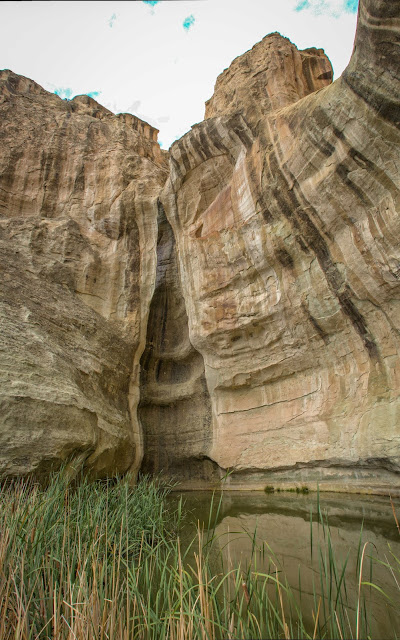Out in western New Mexico there's a huge sandstone bluff that is visible for miles. It's called "El Morro," which literally translates as "The Nose."
Besides being visually distinctive, El Morro has a reliable waterhole hidden at its base.
Consequently, it became a popular oasis for Native Americans, Spanish, and American travelers over hundreds of years. We know this because thousands of visitors have inscribed their names and dates into the sandstone around the base of the 200-foot high cliffs. The carvings are visually interesting, and the stories of some of the inscribers provide a fascinating glimpse into the history of New Mexico.
The earliest marks, of course, are undated petroglyphs made by Ancestral Puebloans centuries before Europeans arrived:
In the early 1600s, the Spanish explorers began to arrive and record their presence in delicate, graceful script:
Of course, the Spanish invasion was anything but delicate and graceful. You can read more about it by clicking here.
The first identifiable European inscription was made in 1605 -- two years before the English settlement of Jamestown in Virginia -- by Don Juan Oñate (or, more likely, by one of his soldiers), the first Spanish "governor" of New Mexico returning from an expedition to the Pacific Ocean:
It says:
"Paso por aqui el adelanto don ju de onate del descubrymiento de la mar del sur a 16 de abril de 1605"
"Here passed by the Governor-General Don Juan de Oñate from the discovery of the South Sea [actually, the Gulf of California] the 16th of April 1605"
In 1636, while the Pilgrims were still struggling for a foothold in New England, another Spaniard -- Juan de Archuleta -- came to El Morro:
The inscription reads:
"Pasamos por aqui el sarjento mayor y el capitan Ju de Arechuleta y al aiudante diego martin barba 7 el alferes Agustin de yno jos ano de 1636"
"We passed by here the Sergeant Major and Captain Juan de Archuleta and the Adjutant Diego Martin Barba and the Ensign Augustin de Ynojos the year of 1636"
In 1680, the Puebloans revolted against the Spanish occupation. Twelve years later (1692), Diego de Vargas was sent to re-establish the New Mexico colony. In the process, de Vargas came to El Morro and left his record:
The inscription reads:
"Aqui estuvo de General Don Diego de Vargas quien conquisto a nuestra Santa Fe y a la Real Corona todo el Nuevo Mexico a su costa, ano de 1692"
"Here was the General Don Diego de Vargas, who conquered for our Holy Faith, and for the Royal Crown, all of New Mexico at his own expense [in the] year 1692"
Here are a couple more Spanish inscriptions from 1709 and 1726:
 |
| Ramon Garzia Jurado, 1709 |
 |
| Don Joseph de Payba Basconzelos, 1726 |
You can read more about Oñate, de Vargas, Archuleta, and Jurado by clicking here.
After the Mexican-American War (1846-48), the Spanish hegemony in New Mexico ended and Americans from the east began passing by El Morro on their way to California. Hundreds of them added to the inscriptions on the base of the cliffs.
One of the most exquisite inscriptions is that of Edward Pendleton Long from Baltimore, who, at age 25, arrived at El Morro on March 21, 1859:
Long was part of a federally-funded expedition headed by Edward F. Beale to establish a wagon road along the 35th parallel for use by the military and emigrants from the east. When the Civil War began two years later, Long enlisted in Lee's Army of Northern Virginia, and survived major battles at Bull Run, Antietam, Chancellorsville, Fredericksburg, and Cold Harbor. He died in 1878.
After the Civil War, traffic headed west exploded, and so did the inscriptions on El Morro:
In 1881 the Central Pacific railroad crossed the Continental Divide in northern New Mexico, and soon the route past El Morro became obsolete as a long-distance thoroughfare. But traditional Native American and settler traffic within New Mexico continued, as did the carvings until 1906, when El Morro was designated as a National Monument, and all carving or writing on the cliffs was prohibited.
If you want to learn more about El Morro, click here. If you would like to see these images (and more) in a larger format, please visit my photography website, Todos Juntos Photography, by clicking here.
Enjoy!


















No comments:
Post a Comment